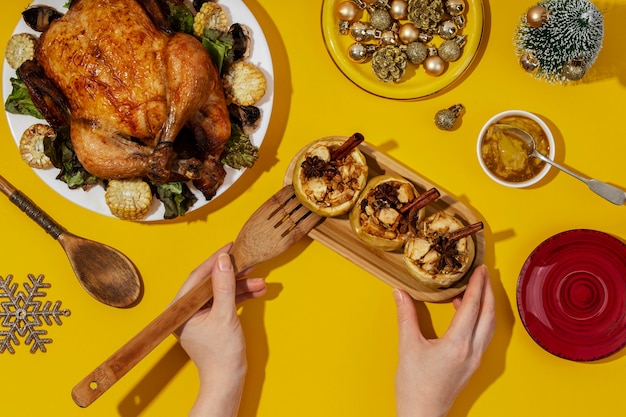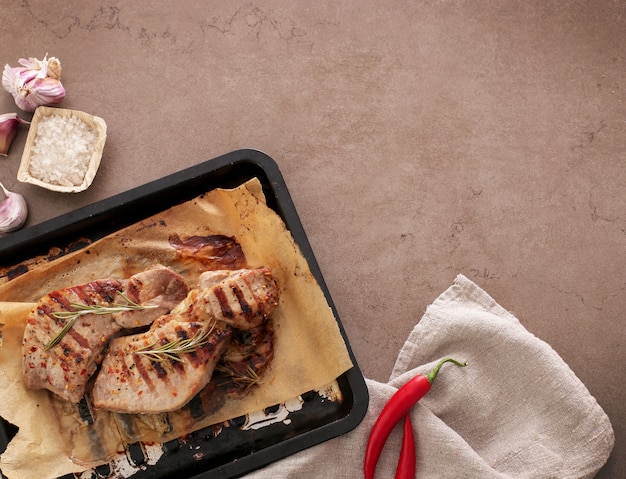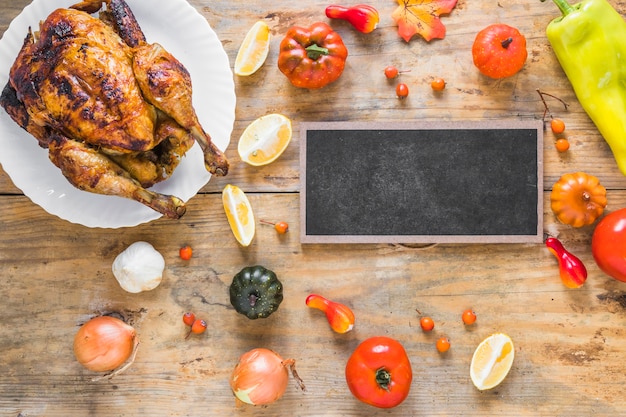(Part 1) choosing the right cut
This is where it all begins. You need to choose the right cut of meat for the occasion. Let's be honest, a good roast is the hero of the Sunday lunch. It's got to be a cut that can stand up to a bit of roasting time, something with enough flavour to justify the effort.Beef

Topside
A classic choice for a roast, topside is lean and great for carving. It's the go-to for a roast that slices beautifully. I usually roast it for a good couple of hours, which allows the juices to distribute evenly throughout. This gives you a roast that's incredibly tender and juicy.
Rib of Beef
Rib of beef, oh boy, that’s what I call a proper roast. It’s a bit more expensive, but the flavour is incredible. It’s best roasted bone-in, as the bone adds a lovely depth of flavour and helps to keep the meat moist. You'll be rewarded with melt-in-your-mouth tenderness. Just remember to rest it properly after cooking, which allows the juices to redistribute throughout the meat. This is crucial for a juicy, flavourful roast.
Sirloin
A lean cut with a good amount of marbling, sirloin is a crowd-pleaser. It’s perfect for roasting medium-rare or medium, as it tends to be quite tender. If you like your beef a little less well-done, sirloin is your cut.
Lamb

Leg of Lamb
A real treat, lamb is bursting with flavour and a slight sweetness. Leg of lamb is a great choice for a family roast. I usually roast it for about an hour and a half to two hours, depending on how well done you like it. The secret here is to use a meat thermometer to ensure that it’s cooked to the desired internal temperature. It's a foolproof way to avoid overcooking.
Shoulder of Lamb
Shoulder of lamb is a great option if you want something a bit more budget-friendly. It’s got a lot of flavour and can be cooked for longer, making it perfect for slow roasting. This is where the magic of slow cooking comes in. It allows the tough cuts of meat to break down, resulting in incredibly tender and succulent results. I like to use a little bit of rosemary and garlic to add some extra flavour, enhancing the natural sweetness of the lamb.
Pork

Loin of Pork
Loin of pork is another excellent choice for a Sunday roast. It’s a tender cut that cooks quickly, which means it’s perfect for a weeknight dinner as well. I always make sure to cook it to an internal temperature of 145°F, which ensures that it’s cooked through without being dry. This is especially important with pork, as it can easily become dry if overcooked.
Shoulder of Pork
Shoulder of pork is a great choice if you want a roast that will fall apart when you carve it. It’s a lot less expensive than other cuts of pork, and it’s perfect for slow roasting. I usually roast it for about 4-5 hours, until it’s incredibly tender and juicy. You can even use it for pulled pork sandwiches. It's a very versatile cut of meat.
Chicken
A classic Sunday roast staple. Whole chicken is a great choice for a family roast. Just make sure you’ve got a big enough roasting pan, and don’t forget the potatoes, carrots, and parsnips! The combination of chicken, roasted vegetables, and gravy is truly a classic.
Not as traditional, but great for a smaller roast. It’s more tender than thighs, but it can dry out quickly. Keep an eye on it in the oven. You can try roasting chicken breasts with a little bit of butter and herbs to keep them moist and flavorful.
Other Roasts
Duck
A bit fancier, but duck is super tasty, especially if you roast it with some orange slices and a little honey. It’ll make your kitchen smell incredible! Duck is a bit more challenging to roast, but the reward is definitely worth the effort. It’s a flavourful and impressive roast that will impress your guests.
Goose
For a truly special occasion, try a goose roast. It’s a big bird, so plan accordingly, and get your gravy ready! Goose is a traditional holiday roast, and it’s a real treat. It’s a bit of a commitment, but it’s well worth it.
(Part 2) Preparing the Meat
Now that you've chosen your cut, let’s get into the prep.Seasoning and Rubs
The key to a delicious roast is to get the flavour right from the start. I always start with salt and pepper, a good generous coating, and then I add my own little twist. Here are a few of my favourite seasoning combinations:
- Rosemary and Garlic: This is a classic combination for roast lamb and beef. Just rub some fresh rosemary and garlic onto the meat before roasting. The combination of rosemary and garlic adds a lovely herbaceous and savory flavour to the roast.
- Herbs de Provence: This blend of dried herbs is perfect for chicken and pork. I like to add a bit of paprika for a smoky flavour. Herbs de Provence adds a complex and fragrant flavour profile to the roast.
- Smoked Paprika and Chili Powder: For a spicy kick, try adding smoked paprika and chili powder to your roast. This is particularly good with pork and duck. The smoky paprika and chili powder add a wonderful depth of flavour and a touch of heat.
Don't be afraid to experiment with different seasonings. Try adding some Dijon mustard, a bit of paprika, a sprinkle of cayenne, or a pinch of dried thyme. It all comes down to personal preference, but a little experimentation can take your roast to a whole new level.
roasting temperature and Time
This is where things get technical, and I’m here to help you nail it. It's all about understanding the meat and the oven. We need to cook it to perfection, ensuring that the inside is juicy and the outside is nicely browned.
Here’s a helpful table that lists the typical roasting temperatures and times for common roasts:
| Meat | Roasting Temperature (°F) | Roasting Time (per lb) |
|---|---|---|
| Beef (rare-medium rare) | 450°F (232°C) | 12-15 minutes |
| Beef (medium-well) | 425°F (218°C) | 15-20 minutes |
| Lamb (medium) | 350°F (177°C) | 15-20 minutes |
| Pork (medium) | 350°F (177°C) | 15-20 minutes |
| Chicken (whole) | 350°F (177°C) | 15-20 minutes |
Remember, these are just guidelines. The exact roasting time will depend on the size and thickness of your cut of meat, and how well done you like it. Use a meat thermometer to ensure that your roast is cooked to the desired internal temperature. This is crucial for ensuring a safe and delicious roast.
(Part 3) The Magic of Basting
Right, this is where we really start to add that extra wow factor. Basting is all about keeping the roast moist and adding even more flavour.
Why Basting is a Must
Imagine a roast, perfectly cooked, with a crisp, golden-brown exterior. Now imagine that, but the inside is a little dry, a touch underwhelming. That’s what happens when you don’t baste. Basting, essentially, is like giving the roast a little drink of its own juices, keeping it moist and succulent. It also helps to create that beautiful, even browning.
What to Baste With
There are a few things you can use to baste your roast. My favourite is butter, it just adds so much richness and flavour. You can also use pan drippings, wine, or even stock.
If you’re using butter, melt it in a small saucepan and then brush it over the roast every 20-30 minutes. If you’re using pan drippings, simply spoon them over the roast. If you’re using wine or stock, make sure it’s hot before you pour it over the roast. This helps to keep the meat moist and prevents it from becoming dry.
(Part 4) The Art of Resting
This might sound a bit counterintuitive, but resting a roast is absolutely crucial. It’s a bit like letting the juices settle down, redistribute throughout the meat. You’ll end up with a more tender, flavorful roast.
Why Resting is Essential
When you roast meat, the juices tend to concentrate towards the centre. As the roast cools, the juices have a chance to redistribute themselves, resulting in a much more evenly-cooked roast. Think of it as giving the juices a little chance to mingle.
How Long to Rest
A good rule of thumb is to rest your roast for at least 10-15 minutes for every pound of meat. That’s the magic number. It might seem like a long time, but trust me, it’s worth it.
You can wrap the roast in foil while it rests to keep it warm. That way, the juices don’t escape, and you end up with a succulent, flavourful roast.
(Part 5) The Sidekick: Roasting Vegetables
Roast dinners are all about the combination of flavours, and the vegetables play a crucial role. These aren’t just side dishes; they’re part of the symphony. They’re a perfect complement to the roast, adding their own unique flavours and textures.
The Essentials
When it comes to roasting vegetables, potatoes, carrots, and parsnips are the classic trio. These three just sing in harmony with any roast. They soak up the flavours of the roasting pan, becoming soft, caramelized, and oh-so-delicious.
Other Options
But don’t limit yourself to the classics. You can add other vegetables to your roast, like Brussels sprouts, onions, garlic, butternut squash, or even broccoli. Just make sure to choose vegetables that cook at a similar rate to your roast. You want everything to be cooked to perfection.
Tips for Perfect Roasting Vegetables
Here are a few tips for roasting vegetables that will impress your guests:
- Cut them into uniform pieces: This ensures that they cook evenly.
- Toss them in oil and seasoning: A good drizzle of olive oil and a sprinkle of salt and pepper will make a world of difference.
- Don’t overcrowd the pan: This will prevent them from steaming instead of roasting.
- Roast them alongside the meat: This gives them a chance to soak up the flavours of the roast.
Remember, you can play around with the roasting time. If you prefer your vegetables crispier, you can roast them for a little longer. And if you like them softer, you can roast them for a shorter time. It’s all about finding the perfect balance for you.
(Part 6) The Glory of Gravy
Now, we’re talking. Gravy is the finishing touch, the glue that binds the whole meal together. It’s the rich, flavorful sauce that elevates your roast to a whole new level.
Making Gravy from Scratch
Making gravy from scratch might seem daunting, but it’s actually quite simple. You’ve got the pan drippings, and that’s your base. You can use flour, cornflour, or even a mix of both to thicken it. And then there’s the magic ingredient – stock, beef stock if you’re roasting beef, chicken stock if you’re roasting chicken, and so on.
The Steps
First, deglaze the pan with a little wine or stock. This means scraping up all those lovely, caramelized bits stuck to the bottom of the pan, the essence of flavour. Then, whisk in your thickening agent, and stir it until it’s smooth. Finally, add your chosen stock and bring it to a simmer until it thickens.
Tips for the Perfect Gravy
Here are a few tips to make your gravy extra special:
- Use good quality stock: This makes a world of difference in the flavour of your gravy.
- Don’t overcook it: Gravy can quickly become thick and clumpy if you overcook it.
- Strain it before serving: This removes any lumps and bits of food.
- Add a touch of flavour: You can add a little bit of Dijon mustard, Worcestershire sauce, or even a teaspoon of honey to your gravy for extra depth of flavour.
Gravy is one of those things that you can adapt to your liking, Add a splash of red wine to give it a deeper flavour, or try using a different type of stock. The possibilities are endless!
(Part 7) The Finishing Touches
Okay, your roast is cooked to perfection, it’s rested, the vegetables are golden and caramelized, and your gravy is rich and flavorful. Now it’s time for the finishing touches, those little extras that make your roast dinner truly memorable.
Side Dishes
While the roast and vegetables are the main event, the side dishes are the supporting actors, adding variety and texture to the meal.
- yorkshire puddings: A classic British staple, Yorkshire puddings are a must-have for any roast dinner.
- Sausages: Sausage and mashed potatoes is a match made in heaven.
- Mashed potatoes: A creamy and comforting side dish that goes with everything.
- green beans or peas: These add a touch of freshness and vibrancy to your plate.
- roast potatoes: A must-have accompaniment for any roast dinner.
Presentation
Presentation matters! It’s about making your meal look as good as it tastes. So, go ahead and make your roast dinner look like a masterpiece.
- Use a beautiful serving platter: This will elevate your roast to a whole new level.
- Carve the meat with precision: It’s all about the presentation.
- Arrange the vegetables artistically: A little effort goes a long way.
- Add a sprig of rosemary or a bay leaf: A touch of greenery adds a visual appeal.
(Part 8) A Toast to the Roast
There you have it, your ultimate guide to cooking a perfect roast. Now you have the knowledge, the techniques, and the inspiration to create a truly memorable meal. Remember, it’s all about those little details, the love you put into it, and the joy of sharing a delicious meal with your loved ones. So, go ahead, fire up the oven, and make a roast that will leave everyone saying, "That was incredible!”
FAQs
- How do I know if my roast is cooked through?
The best way to check if your roast is cooked through is to use a meat thermometer. Different types of meat have different recommended internal temperatures, so make sure you check the USDA guidelines. For example, beef should be cooked to an internal temperature of 145°F for medium-rare, 160°F for medium, and 170°F for well-done.
- What if my roast is a little dry?
If your roast is a little dry, there are a few things you can do. First, make sure you rested it properly. This will help to redistribute the juices throughout the meat. Second, you can add a little bit of gravy or pan drippings to the meat. Third, you can try making a sauce to pour over the roast. A simple pan sauce made with wine or stock can add a lot of moisture and flavour to a dry roast.
- What’s the best way to carve a roast?
Let the roast rest for a good 10-15 minutes before carving. This will allow the juices to redistribute and make the meat easier to carve. Use a sharp carving knife to make clean slices. Start by carving along the bone, then slice across the grain of the meat. This will prevent the meat from tearing and ensure that you get nice, even slices.
- What are some good accompaniments for roast chicken?
Roast chicken pairs well with a variety of sides, including mashed potatoes, roasted vegetables, stuffing, and gravy. You can also add a touch of sweetness with some cranberry sauce or apple sauce. A classic combination is roast chicken with stuffing, mashed potatoes, gravy, and a side of green beans or peas.
- What’s the best way to reheat a roast?
The best way to reheat a roast is in the oven. Wrap it in foil and bake it at a low temperature until it’s heated through. This will prevent the meat from drying out and keep it moist and tender.
Everyone is watching

Prime Rib Roast Cooking Time Chart: Per Pound Guide
Cooking TipsPrime rib roast. Just the name conjures images of lavish dinners, crackling fires, and hearty laughter. It’s ...

How Long to Bake Potatoes in the Oven (Perfect Every Time)
Cooking TipsBaked potatoes are a staple in my kitchen. They're incredibly versatile, delicious, and surprisingly easy to m...

Perfect Rice Every Time: The Ultimate Guide to Cooking Rice
Cooking TipsAs a self-proclaimed foodie, I've always been a bit obsessed with rice. It's the foundation of countless cuisi...

The Ultimate Guide to Cooking Asparagus: Tips, Techniques, and Recipes
Cooking TipsAsparagus. The mere mention of this spring delicacy conjures up images of vibrant green spears, crisp and burs...

Ultimate Guide to Cooking the Perfect Thanksgiving Turkey
Cooking TipsThanksgiving. Just the word conjures up images of overflowing tables laden with delicious food, the scent of r...
